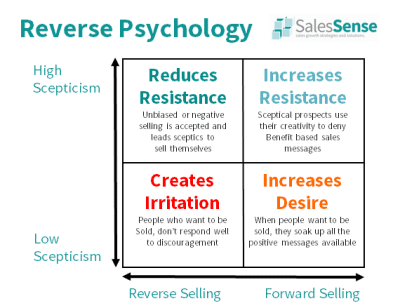Reverse sales is a tactic that uses reverse psychology to weed out prospects that aren’t a right fit, and speed up the process for those that are. By reverse selling you make your prospect realize that they need your product rather than directly trying to sell to them. You do this by giving them the power and control to make an important decision.
Today’s article will guide you through how to leverage reverse sales and use it to pull the most unexpected wins out of the bag.
But first, what even is it?
What is Reverse Sales?
Reverse sales is a technique used to help directly test your prospect’s resolve by flipping the script and suggesting to your prospect that your product may not be the right fit for them.
The aim is that whenever you switch the question to them, you get an instantaneous reaction. For example, if you said, “Maybe this product isn’t right for your company budget at the moment?” Their reaction might be: “Yes, you’re right.” This cuts to the chase and leads to a very straightforward no, saving you time in hounding the wrong lead.
However – and this is the important bit – more often than you might think, the prospect’s gut reaction is to convince you why it’s right for their business. For instance, they might just say, “Actually, we can move the budget allocation around to fit your service into our plans.” In a matter of seconds, you’ve flipped a hesitant prospect into a customer who’s convincing you why they need your product. Genius.
When to Use Reverse Sales
Keep in mind that 62% of consumers are attracted to companies that exhibit ethical values and authenticity. It’s important to still be genuine and authentic in your communication. In fact, reverse selling shouldn’t be overused for this exact reason. We’ll get onto the ethics of it a bit more later, but the key is to keep it as an emergency measure, not an everyday tactic.
It should be used when the conversation is going stale, switching up the direction you’re coming in. When direct methods aren’t working and you’re facing a barrage of objections, reverse sales can be particularly useful. The question you ask should line up with their objections to entice your customer to rethink their stance on the deal. In a sense, it’s almost like a crafty ultimatum, which is why it should be used sparingly.
Think of it this way: when a prospect is skeptical of your product or service, reverse selling will often make them play devil’s advocate. They continue to be skeptical of your negative points, reframing them positively. However, bear in mind that prospects who are already interested in buying will be turned off if you try to use reverse psychology on them. They’re already going down the funnel, you don’t have to turn them upside down.
Check out this awesome infographic below to demonstrate this point even more clearly.

Benefits of Using Reverse Sales
Reverse sales has many benefits if used correctly. Let’s take a deeper dive into a few of them…
Improved Customer Satisfaction
Reverse sales focuses on having an understanding of the customer’s pain points and needs which should help develop trust. Transparency is vital when building a rapport with customers. Research shows that only 18% of buyers trust and respect salespeople. This goes to show the importance of openly discussing potential drawbacks because you demonstrate honesty which builds trust.
If you have the trust of your prospect, a longer term relationship is more likely. You also show your customer you’re not just trying to pull a fast one and you’re actually managing their expectations, preventing them from being disappointed by over-the-top sales promises further down the line.
All in all, reverse sales helps you lay the foundations for a stronger relationship, providing better customer satisfaction in the long run.
Higher Close Rates
When you address potential problems that could arise upfront, you remove the prospect’s barriers to making a purchasing decision. Not only are you showing transparency but you’re also addressing their concerns. By addressing both the positives and the negatives, your prospects will feel you actually have their best interests at heart, leading to more conversions and higher close rates.
Speeds Up the Sales Process
Most of the time you can be met with holding statements like, “I’ll get back to you,” or, “I’ll let you know in a few weeks.” Reverse sales cuts straight to the chase and gets a yes or no answer straight away.
Something like, “[Prospect’s Name], am I correct in assuming you’re not ready to proceed with our service at this moment?” will force your prospect’s hand. They either have to agree and you can move on to better prospects, or you get the opposite answer which puts you a step closer to wrapping up the deal. This will save you both time and effort in the future.
Outside-the-Box Approach
Reverse sales is a unique approach. In a market littered with people trying to sell you something, this method is almost guaranteed to grab your prospect’s attention. Highlighting drawbacks is fairly uncommon, so it will prick their curiosity and encourage prospects to pay closer attention.
Uncovers Hidden Opportunities
When you engage with prospects and focus on the potential challenges and drawbacks of your service, then you might discover some needs that should be prioritized. In particular, pain points that prospects have been keeping buried are often unearthed!
Use these insights as a pathway to address these concerns and discover new opportunities to keep improving.
5 Steps to Implement Reverse Sales in Your Team
It’s all well and good knowing what reverse selling is, but how do you actually use it?
Here are five key steps to follow to implement reverse sales for your team:
Step 1: Use Open-Ended Questions
Open-ended questions are paramount in reverse selling. You provide a platform for your prospects to talk about their needs, concerns, and any challenges they face. These types of questions get your prospect to talk more and reveal information that’s valuable to you without forcing them into a corner with yes/no questions. When you get your customers to talk more, it increases the chances of success, as seen by the 43/57 talk to listen ratio widely considered as the most effective talk time in sales.
You can also take a look at the Mom Test, for example. Although it’s not sales-specific, you can get a deeper understanding of open-ended questions by using it. The idea is that you want to gather valuable and unbiased insights whilst displaying empathy and understanding.
Examples:
- “Can you tell me more about what hurdles your business faces?”
- “What would be the ideal solution for you?”
- “Can you tell me how you’ve tried to combat this in the past?”
Step 2: Implement Scarcity
Make your prospect feel like there’s a chance they could miss out. Suppose you imply that your service is not widely available or limited to a specific type of customer profile. In that case, you can prompt your prospect to show their hand and reveal their true feelings about your product by seeking more information.
Examples:
- “Our product does have limited availability today and it’s not the perfect fit for everyone. Can I ask a few more questions to see if it’s the right fit for you?”
- “Our service is highly specialized and is tailored to 60% of businesses. Can we discuss your requirements to see if you’re happy to go forward with our service?”
Step 3: Use Mirror and Match Technique
Mirror and matching is about copying your prospect to show familiarity and build trust. When you mirror your prospect’s language, tone, and overall demeanor, it can help you build rapport. You can align your communication and style, and relate more, making the conversation more engaging and personable.
This also helps with building trust so that when you finally flip the script, the prospect knows you’re doing it with their best interests at heart. Either they are serious about buying or they’re not.
Step 4: Try to Handle the Prospect’s Objections First
Remember you can’t just start a call and use reverse psychology immediately. You need to limit this technique to only the most skeptical prospects, and even then only when the time is right. First, it’s a good idea to validate their concerns.
If your prospect tells you your plan is too pricey for them, you can rebut it with something like this: “I understand it seems pricey. Many of our clients thought so too until they calculated the ROI and saw how much it actually saved them over time.”
Obviously, this needs to be backed up with actual examples for it to ring true (which it should). If done correctly, you might convince the prospect then and there to move onto the next steps. If they’re still being stubborn, it’s time to play the reverse sales card.
Step 5: Shoot Your Shot
If all the steps have been followed, there’s only one thing left to do. Go for the reverse sell.
Shoot your shot any earlier and you’ll likely confuse them or scare them off. Drag it out any longer and they’ll probably jump at the chance to escape. By targeting them with a reverse sell here, you have the most chance of successfully pulling it off.
Examples:
- “If you’re not 100% sure about moving forward, it’s better to hold off. We want to partner with businesses that are fully ready to commit, and we have others who are ready to take this opportunity right now.”
- “I understand that this might seem like a big commitment right now. Perhaps it’s better to hold off until you’re absolutely sure. That way, we can offer this opportunity to someone who’s ready to take full advantage of it immediately.”
- “I get that the price can seem significant. If you’re not completely sure, it might be wise to take more time to consider. We prefer to allocate our resources to clients who are fully convinced of the ROI and ready to move forward without hesitation.”
Not only do these reversals create urgency in the prospect, they also show confidence in your product which can be a huge selling point in and of itself.
Mike Michalowicz, author of The Pumpkin Plan, has a great reverse psychology technique you can use too. Watch this 2 minute video below to hear him tell it in his own words.
The Role of Sales Leadership in Reverse Sales
You play such a crucial role in helping your sales team adopt the methods of reverse sales. You have to hammer home the importance of fostering a culture focused on being adaptable but completely customer-focused. Lead by example and implement the best training programs for your team and you’ll be on the right path to implementing the skills for reverse sales.
Let’s take a look in more detail…
Company Ethos
Leading by example has to be the first priority. You lay the foundations; the buck stops with you, so ensure an honest and ethical ethos is already in place throughout your entire organization.
Reverse sales can come across as aggressive and if your team doesn’t have the right mentality, it can lead to disagreements with prospects. Furthermore, people often see it as a manipulative tactic as you’re doing it specifically to pressure your customer into a decision. You need your team to know, first and foremost, that this is not a tactic to misuse. Only use it when necessary.
Leadership and Training
In terms of the actual implementation of sales training, you can still lead from the front. When you actively participate in training and show you want to learn, your involvement and commitment to reverse sales will rub off on your team. Don’t just participate, as the sales leader you need to ensure the training is top-notch. Hire experts who specialize in reverse sales if you really want to take this technique to the next level. You can get tailor-made training plans specifically for your sales reps.
Ensure the training is structured, with a step-by-step guide for progress, maybe even include workshops, interactive training, and role-playing. Not only is this informative and educational but it also keeps your team engaged.
Allocation of Resources
Technology is your friend, not your foe. If you allocate your budget wisely, you can invest in tools that facilitate the best training practices. A CRM is a great example as some of them have built-in training modules. Remember expertise comes at a cost, so if you want to adopt reverse sales methods, allocate some of that budget to external trainers and advanced learning materials.
Fostering a Culture of Adaptability
It’s all well and good to introduce new methods to your team, but if your reps aren’t adaptable, it can be a struggle.
You want your team to feel familiar experimenting with new methods. Encourage open communication so your team feels comfortable discussing change and any challenges they feel they might come across with reverse sales.
Customer-Centric Focus
You need to drill into your team the importance of understanding your customer’s needs, goals, and perspectives. Reverse sales require a deeper knowledge of your customer and their psychology. You can only do this by being empathetic and through active listening during conversations with your customers. You can’t just brush the surface with such a complex technique.
It’s not just about understanding each of your customer’s needs, but establishing feedback loops too. This is where your customer can leave an account of their experiences, which you can use to refine your sales processes.
Common Challenges in Reverse Sales and How to Overcome Them
The most common challenges in reverse sales are centered around misunderstandings. Sounds simple right? Well, that depends on how well you’ve implemented reverse sales methods into your company’s ethos.
Common misunderstandings and challenges are as follows…
Not Using the Method Correctly
Challenge: There’s a time and a place to use this method and it should be done sparingly. The way you articulate it is so important. Sometimes you can come across as insincere or just not really bothered about the prospect. This is especially true if you don’t already have an existing rapport with the customer.
Solution: Ensure you train your team on how reverse selling should only be used in the right situation. It should be used sparingly and not in an aggressive approach to selling.
Misunderstanding The Method
Challenge: Your sales team just might not understand the comprehension of using reverse psychology to get someone to buy your product. Some might see it as confrontational and a negative way to attract customers.
Solution: Ensure that everyone is clear on when and why to use reverse sales, and encourage your team to come to you with anything should they have doubts. The goal is to provoke genuine responses and further insights into your customers, not to be just unnecessarily mean or negative for the sake of it.
Resistance From Your Sales Team
Challenge: There’s no doubt that the majority of your sales team is accustomed to more traditional methods of sales. Without proper training, not just the logistics but also the change of mentality needed, it might be hard to sell your whole team on the concept of reverse sales.
Solution: Use role-playing during training modules to demonstrate various scenarios that your team will come across to get them used to it. You can also use real-life examples and showcase the success stories of reverse selling to gradually introduce and integrate this method into your sales processes.
Customer Confusion
Challenge: Your prospect may take it completely the wrong way and see your attempt at reverse sales to be disrespectful. They might even assume that the questions you are posing might be because you’re just trying to move them along with no particular interest in them.
Solution: Make sure your team understands the importance of framing questions carefully. Stress how vital it is to maintain a positive rapport and validate the prospect’s concerns. Reverse sales should not be planned for, but rather rise spontaneously after your usual methods have come back empty-handed.
When NOT to do Reverse Sales
As mentioned earlier, you must guide your team around the ethics of reverse selling. There’s a fine line between applying the method correctly and just being rude. Make sure your sales team knows where the line is.
Reverse sales should be used sparingly and it’s not a technique you should build your entire sales strategy around. It’s essentially a honey trap. If the prospect becomes aware of the ‘trap’ they can feel offended, immediately breaking the trust. It’s a delicate method that could blow up in your face if misplaced or overused.
Is Reverse Sales Right For Your Team?
Reverse sales is a powerful method to build trust and it’s particularly effective at addressing your customer’s needs. It can dramatically hasten the prospect’s journey down the sales funnel, or it can quickly let your reps move on from prospects that are simply wasting their time.
However, it requires an ethical and honest approach. Reverse psychology should only really become a viable option when you’ve reached a stalemate. The prospect is skeptical and unmoving, but also unwilling to simply say “No.” Here, if applied correctly, you can nudge the prospect into making a U-turn and all your sales woes will be relieved.





